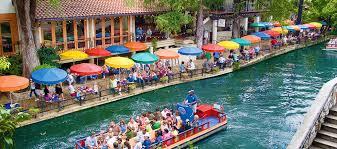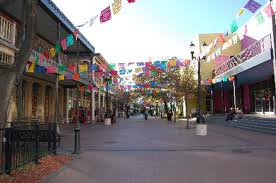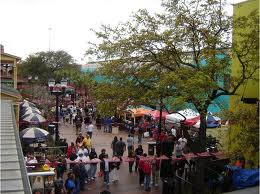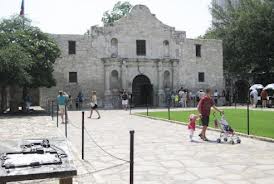Experience Downtown San Antonio
(Thursday Afternoon Tour)

http://www.thesanantonioriverwalk.com/
The San Antonio River Walk is apublic park, open 365 days a year. It is a network of walkways along the banksof the San Antonio River, one story beneath approximately 5 miles of downtownSan Antonio. Lined by bars, shops andrestaurants, the River Walk is an important part of the city's urban fabric anda tourist attraction in its own right.

The River Walk winds and loops under bridges as two parallelsidewalks, lined with restaurants, shops, hotels and more. It connects themajor tourist draws from the Alamo to Rivercenter Mall, Arneson River Theatre and La Villita, the San Antonio Museum of Art, and the PearlBrewery.
The Mexican Market (The Mercado)


An open market as those found in Mexico. Walk about and experience the atmosphere.
 http://www.sanantonio.gov/marketsquare/ The rich culture of San Antonio aboundsthroughout the plazas of Market Square. A three-block outdoor plaza lined withrestaurants, shops and produce stands near San Antonio's city center, MarketSquare is the largest Mexican market in the U.S. It is one of America's top-ten outdoor markets according to Frommer's. Dozens of shops sell everythingfrom hand-embroidered dresses to leather belts. Market Square's workingartists, musicians, dancers and major cultural events give it a rich and livelycultural atmosphere. Visitors browse through 32 shops at "ElMercado," and 80 specialty shops in the Farmers Market Plaza. MarketSquare is also the scene of many Hispanic festivals where food and beveragebooths spring up alongside Guadalajara lamps while the sounds of mariachi musicblends with the excitement of Mexican dances.
http://www.sanantonio.gov/marketsquare/ The rich culture of San Antonio aboundsthroughout the plazas of Market Square. A three-block outdoor plaza lined withrestaurants, shops and produce stands near San Antonio's city center, MarketSquare is the largest Mexican market in the U.S. It is one of America's top-ten outdoor markets according to Frommer's. Dozens of shops sell everythingfrom hand-embroidered dresses to leather belts. Market Square's workingartists, musicians, dancers and major cultural events give it a rich and livelycultural atmosphere. Visitors browse through 32 shops at "ElMercado," and 80 specialty shops in the Farmers Market Plaza. MarketSquare is also the scene of many Hispanic festivals where food and beveragebooths spring up alongside Guadalajara lamps while the sounds of mariachi musicblends with the excitement of Mexican dances.
The Alamo
http://www.thealamo.org/visitors/sanantonio.php
A Brief Historical Overview
An event occurred in San Antonio nearly 170 years ago thatis still remembered today. The historic event, as most visitors to the citywill already know, was the epic Siege and Battle of the Alamo. Nevertheless,those who look for the remains of the battlefield are often disappointed ormystified by what they find at 300 Alamo Plaza. With a little preparation,however, a visit to the Alamo can be a rewarding and educational experience.
The Alamo as it appears today represents nearly threehundred years of human activity. Founded by the Spanish in the late 18thcentury as Mission San Antonio de Valero, the compound has seen many uses.Following the closing of Valero in 1793, the land and buildings were occupiedby the former mission converts. In 1803, Valero became a military barracks whenthe Second Flying Company of San Carlos de Parras took up quarters on thegrounds. The military use continued after Mexico declared its independence fromSpain in 1821. Valero (which local residents had begun to call the Alamo)played its most famous role as a Texian fort during the Texas Revolution. Theheroic stand for liberty taken by the Alamo garrison insured that the sitewould forever be revered.
Revered, but not yet protected from destruction. Situated onthe edge of San Antonio de Béxar, the Alamo was destined to be surrounded bythe growing town. From 1847 until 1876 (excluding the years 1861-1865), theUnited States Army occupied the site as a Quartermaster Depot. Once themilitary moved to Government Hill - the post that would become Fort Sam Houston- commercial interests gained control of the property, establishing a generalstore on the grounds of the Alamo. Although the State of Texas purchased thechurch in 1883, the remaining original structure - the Long Barrack - remainedin private hands. In 1903, the Daughters of the Republic of Texas acquired theLong Barrack and shortly thereafter turned the deed over to the State of Texas.The State Legislature, in turn, appointed the DRT custodians of the Alamo withinstructions to maintain it as a memorial to those who died there in thedefense of Texas liberty. Since 1905, the Alamo has been a Shrine to the AlamoHeroes.
What Is There To See And Do?
Visitors today can enter the Alamo grounds from severaldirections. Five gates permit access to the complex. Many people, however,prefer to first enter the old church or modern Shrine. Inside the old churchare exhibits displaying artifacts associated with the Alamo Heroes: Travis’ring, Crockett’s buckskin vest, a flintlock rifle used in the battle; a periodBowie knife, and more. An arrangement of flags represent the states and nationsfrom which the defenders came. Somewhat disguised by this serene setting is thefact that this building was the scene of fierce fighting during the 1836 battle.
Exiting the Shrine, one has a choice of what to see next. Tothe right and over the footbridge are the Alamo Gardens with their carefullymanicured lawns and flower beds. A turn to the left takes one past an outdoorexhibit called the Wall of History. Visitors who desire to learn more about theAlamo’s 300 year long history should plan to spend time at this unique outdoorexhibit. To the west of the Wall of History, across Convento Courtyard, is theLong Barrack Museum. Opened in 1968, the museum contains the Clara DriscollTheater where visitors may view a seventeen-minute film on the Alamo, a filmproduced by The History Channel exclusively for the site. The Long BarrackMuseum also houses exhibits on the Alamo that explain its evolution frommission to fortress and finally to Shrine. Directly across from the Shrine exitis the Alamo Gift Museum. Built in 1936, the building contains exhibits on theAlamo and Texas History. These exhibits currently included Mexican militaryartifacts, long rifles, bowie knives, and Alamo archeology. Gifts and books onthe Alamo are available for sale inside the Gift Museum. Other points ofinterest are several cannon actually used in the famous battle located inCavalry Courtyard and the scenic massive Live Oak Tree in Convento Courtyard,planted in 1914 to beautify the grounds.
There's More To The Alamo Than The Modern Compound
More traces of the Alamo of 1836, although hidden by amodern urban landscape, still can be found if one only knows where to look. Asignificant portion of the battle took place in Alamo Plaza, which roughlyretains the outline of the interior of the old mission and fort. Acommemorative plaque marks the spot where the Low Barrack once stood, a onestory building which served as the entrance to the compound and the quarters ofJames Bowie. One can see original foundation stones near the stairway leading downto the Paseo del Rio. The location of the Palisade, a section of the fortdefended by David Crockett and the Tennessee Volunteers, is marked in the plazawith paving stones. The north wall where William B. Travis was killed now liesunder the U.S. Post Office Building. Even with all its modern features, thehistoric Alamo compound is still recognizable to the educated eye.